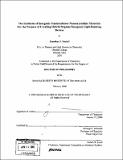| dc.contributor.advisor | Moungi G. Bawendi. | en_US |
| dc.contributor.author | Steckel, Jonathan S. (Jonathan Stephen) | en_US |
| dc.contributor.other | Massachusetts Institute of Technology. Dept. of Chemistry. | en_US |
| dc.date.accessioned | 2008-02-28T16:24:54Z | |
| dc.date.available | 2008-02-28T16:24:54Z | |
| dc.date.copyright | 2006 | en_US |
| dc.date.issued | 2006 | en_US |
| dc.identifier.uri | http://dspace.mit.edu/handle/1721.1/34493 | en_US |
| dc.identifier.uri | http://hdl.handle.net/1721.1/34493 | |
| dc.description | Thesis (Ph. D.)--Massachusetts Institute of Technology, Dept. of Chemistry, 2006. | en_US |
| dc.description | Includes bibliographical references. | en_US |
| dc.description.abstract | Colloidal semiconductor nanocrystals (NCs) or quantum dots (QDs) can be synthesized to efficiently emit light from the ultraviolet, across the entire visible spectrum, and into the near infrared. This is now possible due to the continual development of new core and core-shell NC structures to meet specific color needs in areas as diverse as optoelectronic devices to biological imaging. Core-shell semiconductor NCs are unique light emitters. They are more stable overtime to photobleaching compared to organic dyes. Their emission is efficient and their spectral full width at half maximum remains highly narrow as their size is synthetically changed to provide desired peak wavelengths of emission to within plus or minus a couple of nanometers. They can be purified and manipulated in solution and their chemical interaction with the environment is the same for all sizes and can be modified using chemical techniques. These unique properties make semiconductor NCs ideal for use in light emitting devices (QD-LEDs). This work shows how electroluminescence can be extended into the near infrared region of the spectrum by employing infrared emitting NCs as well as into the blue region of the spectrum by designing and synthesizing NCs specifically for this application. | en_US |
| dc.description.abstract | (cont.) Once efficient and color saturated electroluminescence at the visible spectrum's extremes had been realized it was a natural extension to begin exploring the potential of QD-LED devices to satisfy the technological requirements of flat panel displays and imaging applications. This led to the synthesis of a new green-emitting core-shell NC material to meet the specific color needs for flat panel display applications. At the same time we developed a new QD-LED device fabrication method to allow the patterning of the NC monolayer in our devices. Micro-contact printing the NC monolayer instead of using phase separation provided efficient and highly color saturated QD--LEDs in the red, green, and blue, and allowed us to pattern these monolayers towards the development of pixelated QD-LEDs such as needed for flat panel display applications. Along the way, the synthesis of colloidal NCs was studied to allow for more control in synthesizing higher quality materials in the future. The simple synthesis of PbSe NCs was used as a model system to begin to understand the mechanism of how the molecular precursors are reduced in solution to produce solid crystalline material in the presence of phosphorous containing molecules. | en_US |
| dc.description.statementofresponsibility | by Jonathan S. Steckel. | en_US |
| dc.format.extent | 213 p. | en_US |
| dc.language.iso | eng | en_US |
| dc.publisher | Massachusetts Institute of Technology | en_US |
| dc.rights | M.I.T. theses are protected by copyright. They may be viewed from this source for any purpose, but reproduction or distribution in any format is prohibited without written permission. See provided URL for inquiries about permission. | en_US |
| dc.rights.uri | http://dspace.mit.edu/handle/1721.1/34493 | en_US |
| dc.rights.uri | http://dspace.mit.edu/handle/1721.1/7582 | |
| dc.subject | Chemistry. | en_US |
| dc.title | The synthesis of inorganic semiconductor nanocrystalline materials for the purpose of creating hybrid organic/inorganic light-emitting devices | en_US |
| dc.title.alternative | Synthesis of inorganic semiconductor NC materials for the purpose of creating hybrid organic/inorganic LEDs | en_US |
| dc.type | Thesis | en_US |
| dc.description.degree | Ph.D. | en_US |
| dc.contributor.department | Massachusetts Institute of Technology. Department of Chemistry | |
| dc.identifier.oclc | 70851579 | en_US |
